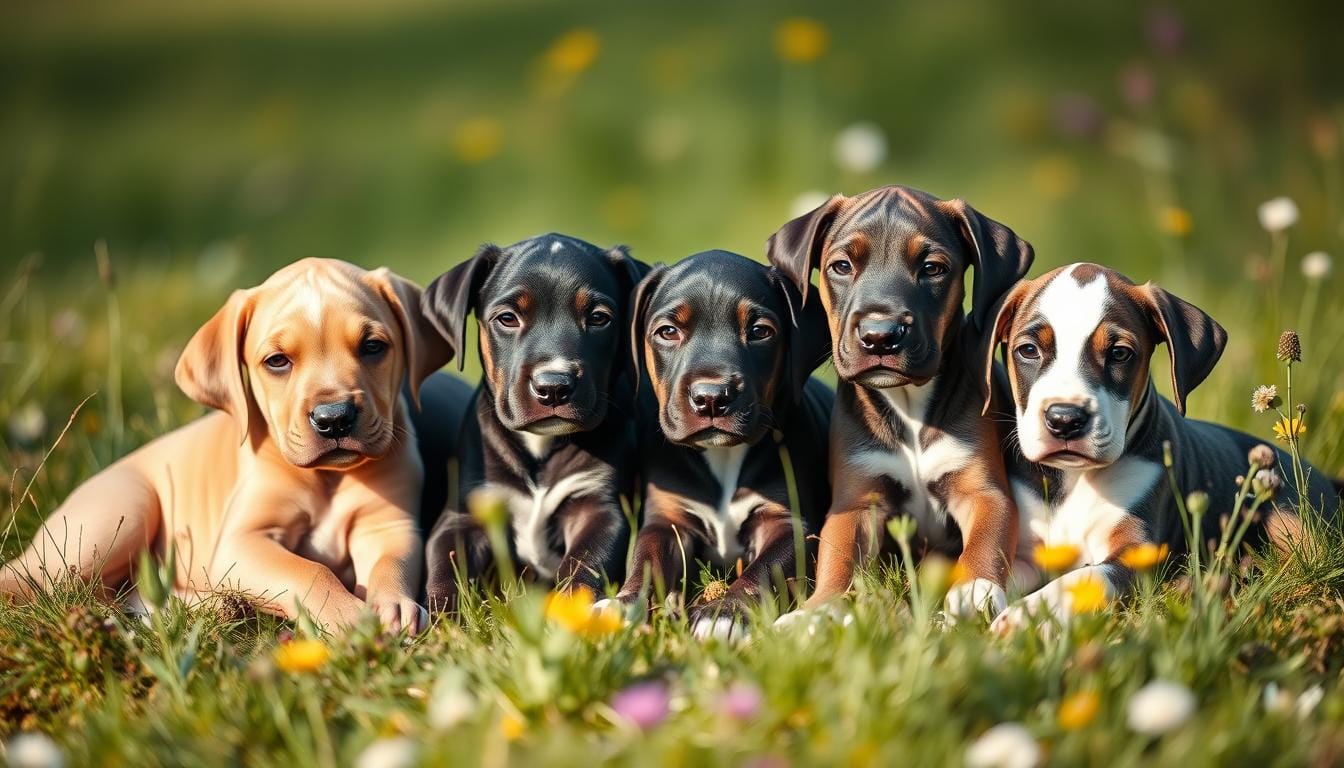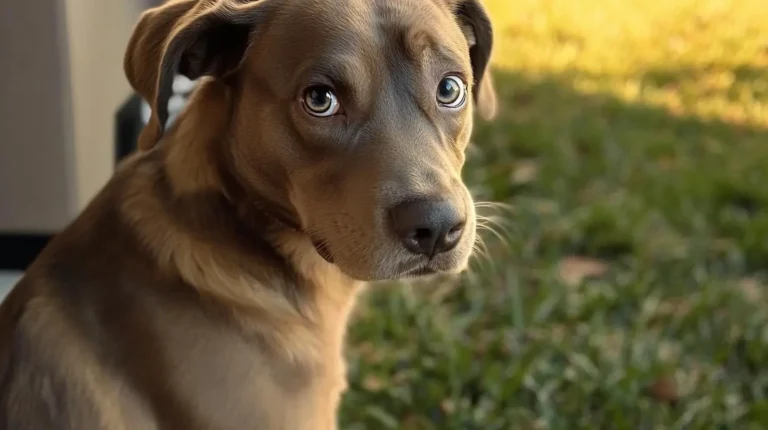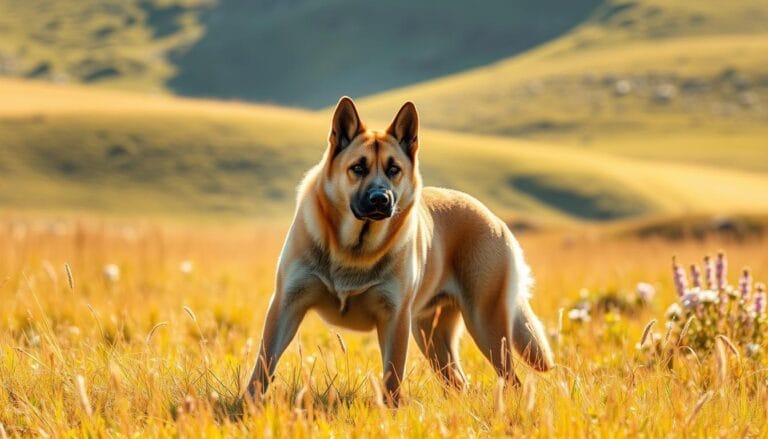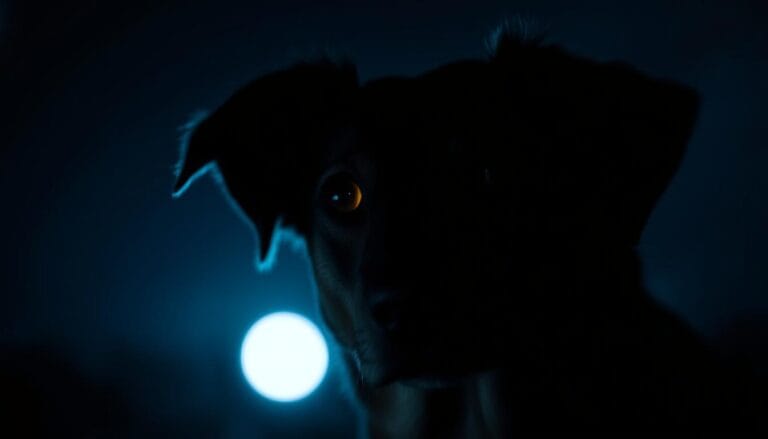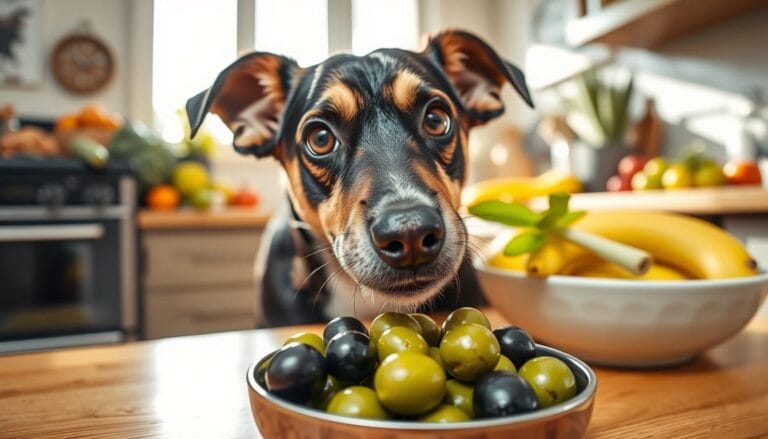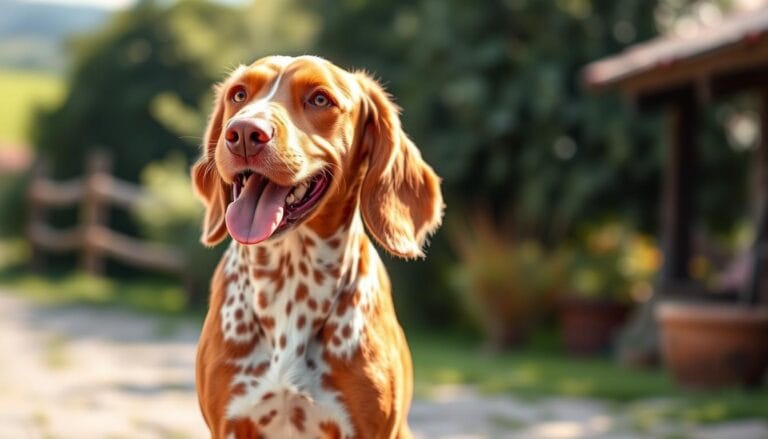Great Dane Puppies: Understanding Their Growth & Weight
Welcoming a Great Dane puppy into your family is exciting. You’ll want to know about their growth and weight. These puppies grow fast and need the right care for their health.
Great Dane puppies are loved for their size and gentle nature. They are big but gentle. With the right care, they can be happy and healthy adults.
Table of Contents
Great Dane puppies start small, weighing 1 to 2 lbs at birth. They grow to 110 to 175 lbs as adults. By 6 months, they can weigh 65 – 100 lbs and be 26 – 33 inches tall. It’s important to watch their growth and make sure they get the right food and care.
Key Takeaways
- Great Dane puppies weigh between 5 – 8 lbs at 1 month and 65 – 100 lbs at 6 months.
- They require proper nutrition and care to support their rapid growth and development.
- Great Danes are prone to health issues, such as canine bloat, and require regular veterinary check-ups.
- Regular exercise, at least 2 hours a day, is essential for their growth and health.
- Seeking veterinary guidance is vital for determining appropriate nutrition and supplement needs for Great Danes.
Understanding the Gentle Giants: Great Dane Puppies
Thinking about getting a Great Dane puppy? It’s key to know their history, unique traits, and personality. These dogs are big and gentle, making them great for families. Originally bred for hunting, they’ve become loving companions due to their loyalty and patience.
Great Danes have a short coat in many great dane colors like Fawn, Brindle, and Blue. They can grow up to 32 inches tall and weigh 175 pounds. Females are slightly smaller. Their size means they need the right diet and exercise.
Historical Background of the Breed
Great Danes have been around for centuries, starting in the 16th century. They were first used for hunting but are now loved as family pets. Their loyalty and patience make them perfect for families with kids.
Distinctive Characteristics of Great Danes
Great Danes stand out for their size, short coat, and gentle nature. They are loyal and patient, making them great family pets. Here are some key traits:
- Large size, with males reaching up to 32 inches in height and weighing as much as 175 pounds
- Short coat, which comes in various great dane colors
- Gentle temperament, making them a popular breed as family pets
- Loyalty and patience, making them a great choice for families with children
Temperament and Personality Traits
Great Danes are known for being gentle and loving. They are patient and loyal, perfect for families with kids. They also need social interaction and exercise to avoid getting anxious when left alone. With the right care, they make wonderful family pets.
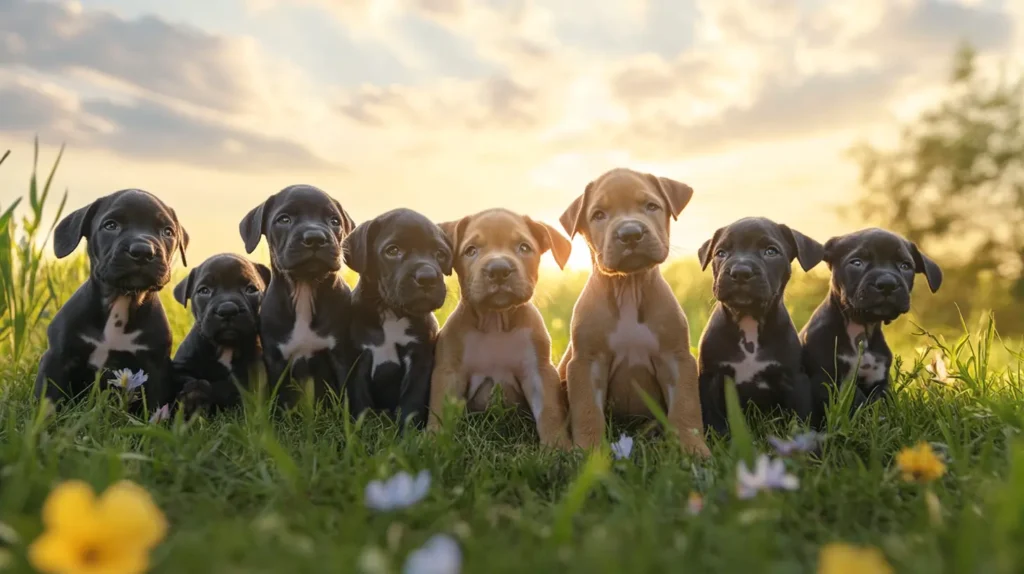
The Growth Journey of Your Great Dane Puppy
As a Great Dane owner, it’s key to know about your puppy’s growth. From birth to adulthood, Great Danes change a lot in weight and height. Newborns weigh 1 to 2 pounds, while adults can reach 110 to 175 pounds. Great Dane breeders are vital in watching these puppies grow, making sure they get the right food and care.
A healthy Great Dane puppy can grow 2 to 3 pounds a week early on. By 8 weeks, they might weigh 15 to 30 pounds. Here are some important growth milestones for a Great Dane puppy:
- 6 months: 65 to 100 pounds
- 12 months: 95 to 140 pounds
- 18 months: growth rate slows down, but continues until about 2 years of age
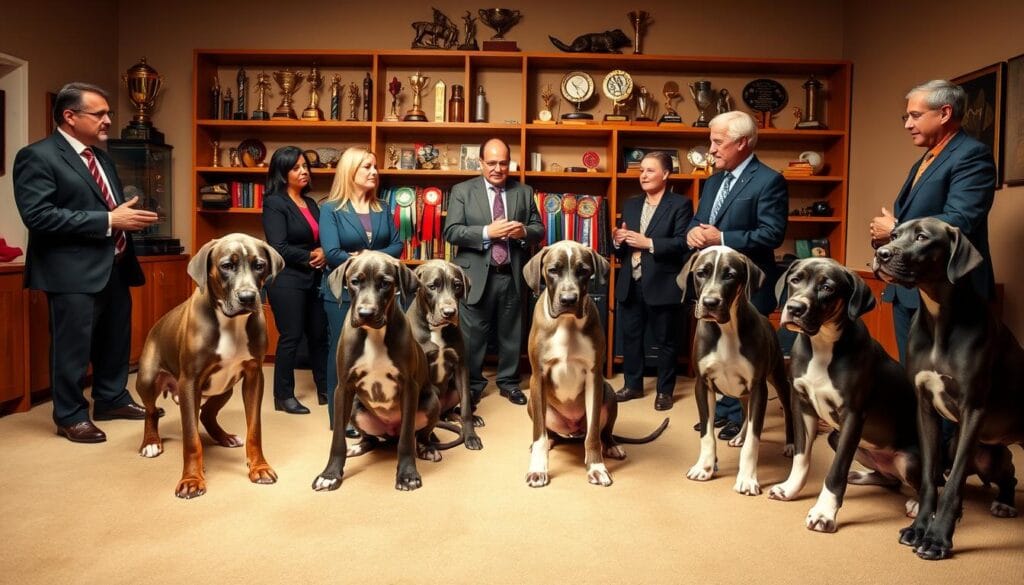
It’s important to keep track of your puppy’s growth and health. Great Dane breeders can offer great advice on monitoring growth and solving any problems. By teaming up with trusted great dane breeders, you can help your puppy become a happy and healthy adult dog.
Common Great Dane Colors and Markings
Great danes puppies come in many colors and markings. The American Kennel Club lists six main colors: Fawn, Black, Blue, Brindle, Harlequin, and Mantle. You can also find white patches or a black mask on them.
Some colors, like merle, might lead to health issues. Knowing the genetics behind colors and markings is key to getting a healthy puppy. For instance, mixing a Fawn with a Mantle can give you all black puppies. A Brindle and Harlequin mix can result in many colors and patterns.
Standard Color Variations
Here are some common colors in great danes puppies:
- Fawn: a solid fawn color with a black mask and ears
- Black: a solid black color
- Blue: a solid steel blue color
- Brindle: a base coat of fawn or black with black stripes
- Harlequin: a white base coat with irregular black torn patches
- Mantle: a black base coat with white markings
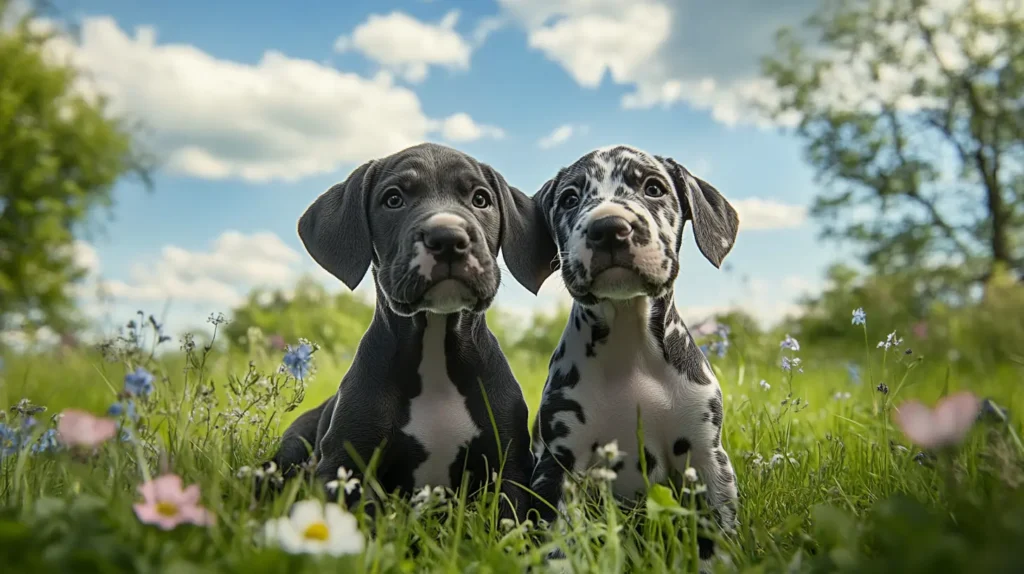
Merle Patterns and Genetics
Merle patterns are stunning but can be linked to health issues. It’s vital to grasp the genetics of merle patterns for a healthy puppy. Merle great danes can have colors like gray, silver, and blue, with black patches.
Weight Milestones in Great Dane Development
As a owner of merle great dane puppies, tracking their weight is key. Great Dane puppies grow fast, and their weight can jump up quickly. Watching their weight helps you adjust their diet to avoid health issues.
Here are the typical weight milestones for Great Dane puppies:
- At 1 month: 6–8 pounds
- At 2 months: 20–30 pounds
- At 3 months: 30–45 pounds
- At 4 months: 45–65 pounds
- At 5 months: 65–85 pounds
- At 6 months: 75–100 pounds
Merle great dane puppies can reach their full height by 18 months. They keep gaining weight until they are 24 months old. A balanced diet and exercise are vital for their weight and health.
Genetics play a big role in a Great Dane’s size, including their parents’ weights. Stress or illness can slow growth, but panosteitis usually doesn’t stop them from growing. Knowing the weight milestones of your merle great dane puppies helps you care for them better.
Nutrition Requirements for Healthy Growth
As a Great Dane puppy owner, you want the best for your pet. Proper nutrition is key, more so in the first year when they grow fast. A balanced diet with protein, fat, carbs, and vitamins is essential for their health.
Feeding your Great Dane puppy right is important. They need a special mix of calcium and phosphorus for strong bones. A ratio of 1.1:1 to 1.4:1 is best. Too many calories can cause obesity and bone issues, so watch their weight closely.
Puppy-Specific Dietary Needs
Great Dane puppies need a diet that supports their fast growth. Feed them high-quality food made for large breed puppies. This ensures they get the nutrients they need for healthy growth.
Feeding Schedule Guidelines
Having a good feeding schedule is key. Feed your puppy 3-4 times a day, with the last meal 2 hours before bed. Watch their food intake and adjust as needed to avoid overeating. Regular weight checks help track their growth.
Some important feeding tips for your Great Dane puppy include:
- Provide a balanced diet for healthy growth
- Monitor their weight and adjust food intake
- Avoid too many calories during growth
- Limit heavy exercise until they’re 2 years old
By following these guidelines and giving your Great Dane puppy a balanced diet, they’ll grow into a healthy adult dog. Always get advice from your vet for your puppy’s specific needs.
Exercise and Activity Guidelines for Growing Great Danes
As a responsible owner of great danes puppies, it’s key to give them regular exercise and play. Great dane breeders suggest Great Danes need about 2 hours of activity daily. This should be split into two walks.
Here are some guidelines to keep in mind:
- Great Danes should not do strenuous activities like jogging or hiking before they’re 2 years old. This helps avoid joint damage.
- Regular exercise keeps them at a healthy weight. This lowers the risk of obesity-related problems like diabetes and joint issues.
- Older Great Danes might need less exercise. This is true if they have age-related conditions like arthritis or hip dysplasia.
It’s also important to watch for signs of overheating. Look for heavy panting, drooling, and glazed eyes. These signs mean they need to stop activity right away. By following these guidelines and creating a safe space, you can help your great danes puppies grow into happy and healthy adults.
Health Screening and Veterinary Care
As a Great Dane owner, it’s key to focus on your dog’s health. Regular vet visits are a must. Great Danes face health risks like skeletal dysplasia and bloat, which can be deadly. Early detection is possible with regular vet check-ups, ensuring your merle great dane puppies or dogs of other great dane colors get the care they need.
Great Danes often deal with hip dysplasia, heart issues, and cancer. Your vet might suggest tests like echocardiograms or hip X-rays. Keeping up with preventive care, like vaccinations and dental care, is also important. This helps avoid problems like GDV or dental disease.
To keep your Great Dane healthy, team up with your vet to create a health plan. This might include blood tests, thyroid screenings, and watching for cancer or other diseases. By focusing on your dog’s health and getting help from a vet, your Great Dane can live a long, joyful life. This is true for any great dane colors or breed characteristics.
Selecting Reputable Great Dane Breeders
When looking for great dane puppies, finding a reputable breeder is key. A good breeder focuses on the health and happiness of their dogs. This reduces the chance of health issues like weight problems in great danes.
Look for a breeder who knows a lot about the breed and loves it. They should be open about the puppy’s health, personality, and family background. You’ll likely spend between $1,500 and $3,000, depending on the breeder’s reputation and the puppy’s lineage.
What to Look for in a Breeder
- Experience and knowledge of the breed
- Transparency about the puppy’s health, temperament, and ancestry
- Medical histories covering at least four generations back
- OFA certifications to guarantee the puppy’s health
Red Flags to Watch Out For
Watch out for breeders who won’t share medical histories or OFA certifications. Also, be cautious of those who seem more interested in making money than in the dogs’ health. A reputable breeder will care about the puppy’s health and give you all the info you need.
Questions to Ask Before Purchasing
Before buying a great dane puppy, ask about its health, personality, and family history. Also, ask about the breeder’s experience and knowledge. A reputable breeder will answer all your questions and help you make a good choice.
Training Your Great Dane Puppy
As a new owner of great danes puppies, it’s key to start training early. This ensures your puppy grows into a well-behaved adult. Great dane breeders suggest starting with basic obedience, like housebreaking, and then moving to more advanced training.
Training sessions for great danes puppies should be short, about 10-15 minutes. This matches their short attention spans. Consistency is key, and training should happen at the same times every day. A structured training plan can lead to big changes in a month.
Some important tips for training your great dane puppy include:
- Use positive reinforcement, like treats and praise, to encourage good behavior
- Be consistent and patient, as great danes puppies can be stubborn
- Socialize your puppy with other dogs and people to help them develop social skills
Training a great dane puppy takes time, effort, and patience. With the right approach and consistency, your puppy will grow into a well-behaved and loyal friend. If you’re looking for great dane breeders or want to learn more about training great danes puppies, do your research and find a reputable source.
Essential Equipment and Supplies for Your Growing Giant
As a Great Dane owner, you want to ensure your puppy has everything they need to grow and thrive. From crates and bedding to toys and training tools, the right equipment can make a big difference in your puppy’s comfort and development. When it comes to great dane colors, you may be interested in learning more about the unique characteristics of merle great dane puppies.
A suitable crate for a Great Dane puppy must be extra-large. It should allow the dog to stand, turn, and lie down comfortably. The recommended size for a Giant Breed Dog Crate is 54 inches long, 35 inches wide, and 45 inches high. A good bed for a Great Dane puppy needs to be supportive, comfortable, and large enough for growth. You should also invest in a high-quality collar and harness that can accommodate your puppy’s rapid growth.
Here are some essential items to include in your puppy’s care package:
- Comfortable and supportive bedding
- Durable and adjustable collars and harnesses
- Non-toxic and washable toys and chews
- A well-stocked first aid kit with essentials like bandages and antiseptic solution
- High-quality food and water bowls that are easy to clean and minimize strain on your puppy’s neck and joints
Remember to choose equipment and supplies that are durable, comfortable, and safe for your Great Dane puppy. With the right gear, you can help your puppy grow into a happy and healthy adult.
Conclusion: Embracing the Journey with Your Great Dane Puppy
Starting your journey with a great dane puppy is exciting. It’s important to give them the right care and attention. This will help them grow into a happy, healthy, and well-behaved adult.
Feed them well, exercise them regularly, and use positive training. This way, your great dane can reach their full weight and bond with you. Make sure they have a safe, comfy place to live, lots of social time, and a routine.
By being patient, loving, and committed to your puppy’s well-being, you’ll get a lifelong friend. They will bring joy and laughter to your family for many years.
FAQ
What are the characteristics of Great Dane puppies?
Great Dane puppies are known for being gentle and loving. They are big, have a short coat, and show unique traits. Originally used for hunting, they now make great family pets because of their loyalty and patience.
How do Great Dane puppies grow and develop?
Watching a Great Dane puppy grow is exciting but also challenging. You can use a growth chart to track their development. This ensures they get the right food and care.
What are the common colors and markings of Great Danes?
Great Danes come in colors like brindle, fawn, black, and blue. They can also have white patches or a black mask. Merle patterns are common but can lead to health issues.
How much do Great Dane puppies weigh?
Great Dane puppies grow fast, and their weight increases quickly. It’s important to track their weight to make sure they’re eating right.
What are the nutritional requirements for Great Dane puppies?
Great Dane puppies need a balanced diet with protein, fat, carbs, and vitamins. They need a feeding schedule that meets their needs. It’s key to feed them high-quality puppy food made for large breeds.
How much exercise do Great Dane puppies need?
Great Dane puppies need regular exercise and play. They should go for walks, play, and get lots of social time.
What health issues can affect Great Danes?
Great Danes can face health problems like skeletal dysplasia and bloat. They might also have hip dysplasia or heart issues. Regular vet visits and health checks are vital to keep them healthy.
How do I find a reputable Great Dane breeder?
Finding a good breeder is key to getting a healthy puppy. Look for an experienced, knowledgeable, and passionate breeder. Ask about the puppy’s health, temperament, and ancestry.
How do I train a Great Dane puppy?
Training a Great Dane puppy needs patience, consistency, and positive reinforcement. Start with basic obedience and housebreaking. Then, move on to more advanced training. Socialization and plenty of exercise and play are also important.
What equipment and supplies do I need for a Great Dane puppy?
Great Dane puppies need lots of equipment and supplies. This includes crates, bedding, collars, harnesses, toys, and training tools. Choose high-quality, durable, and comfortable items for your puppy.
There are no reviews yet. Be the first one to write one.

